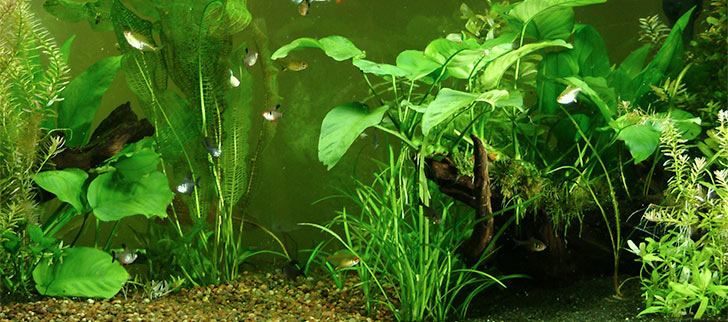
Tips for a Successful Freshwater Planted Aquarium
By avoiding some of the most common mistakes through careful planning and a little forethought, you'll be pleased with your success. The most common reasons for the loss of aquatic plants are:
- The addition of plants that require differing water parameters (incompatible species)
- The addition of plants ill-suited to the existing lighting conditions
Just like fish, aquatic plants do best when they are kept in an aquarium that best suits their needs. Selecting live plants that share common water parameters will minimize problems and will make it easier for you to maintain ideal water conditions. The three main aspects to consider are pH, water hardness, and water temperature.
- pH - Most live plants are tolerant of a pH range between 6.5 and 7.5. However, some sensitive plants have a narrower pH tolerance, so it is important to research the specific pH requirements of each plant.
- Water hardness - Usually expressed in degree of hardness. Though tropical aquatic plants tend to prefer softer water, most plants are able to adapt to harder water conditions (general hardness). Once again, research the specific range your desired plants can tolerate.
- Water temperature - Though most aquatic plants do well within the temperature range of 70° to 80° F, there are several aquatic plants, such as Anacharis and Japanese Dwarf Rush, that prefer cooler water temperatures. Aquarists should find out the particular temperature requirements of each plant.
| Degree of hardness (dH) |
Description of water hardness |
Examples of plants |
| 3 | soft | ChainSwords, Cryptocoryne, Dwarf Sagittaria |
| 3-6 | moderately soft | Anubias Barteri, Rotala Indica, Cabomba |
| 6-12 | slightly soft | Micro Swords, Java Fern, Ludwigia |
| 12-18 | moderately hard | Anubias nana, Melon Sword, Anacharis |
Most aquariums do not have adequate lighting* to sustain many aquatic plant species. Plants that require high lighting conditions are frequently placed in aquariums with insufficient lighting and do not survive or demonstrate anemic growth. Provide the right lighting conditions or select plants that are suited to your current lighting conditions. A planted aquarium should receive at least 10 to 12 hours of light per day.
Low or subdued lighting - 1 watt per gallon
Moderate lighting - 2 watts per gallon
High lighting - 3-4 watts per gallon
Innovations in LED technology offer new lighting options for hobbyists. Look for LED light fixtures specifically designed for live aquatic plant growth as an energy-efficient and cost-saving lighting option.
Other factors to consider
- Substrate - Live plants will thrive when specialized plant substrates such as Seachem Flourite™or CaribSea® Eco-Complete Plant Substrate Eco-Complete Planted Substrate are used, especially for heavy root-feeders such as Anubias.
- Fertilization - Determine the feeding habits of your plants to select the appropriate type of fertilizer: tablets for root-feeders and/or liquid for plants that feed through their leaves.
- Placement - Each plant will grow to different heights and can be categorized as foreground, mid-ground, or background plants (sometimes offered in convenient plant packs). Place the plants in the appropriate location in groupings of odd numbers for a more natural, nonsymmetrical appearance.
- Fish - Carefully select plant-friendly fish for your aquarium. Herbivorous fish such as Silver Dollars are not suitable for planted aquariums since they are avid grazers, and many Cichlids are notorious for digging in the substrate and uprooting plants. Plant-friendly fish to consider are Tetras, Gouramis, Rainbowfish, Livebearers, and Rasboras.
By choosing appropriate plants that best match the lighting and water parameters of your existing aquarium, creating a beautiful, planted aquarium is not as difficult as you might think.
| There are many ornamental terrestrial or marginal tropical plants sold as aquatic plants. These plants may look good and can do fine completely submerged for awhile, but these plants will eventually drown and should not be used. It is very important to select true aquatic species to prevent unnecessary disappointment and loss. Non-aquatic plants you may find in pet stores, but should avoid, include: Aglaonema, Cherry Hedge, Draceana (Princess Pine), Green Hedge, Mondo Grass, and "palms." |